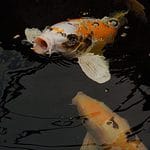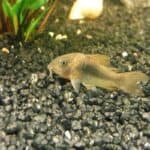Paradise Fish (or Paradise Gourami) are a stunning freshwater fish, and their unique, vibrant, and colorful look makes them a favorite among aquarists.
However, there are a few things to keep in mind when adding a Paradise Fish to your aquarium. Some aspects of their care are easier than others.
For example, they’re hardy fish and keeping them healthy is easy, but their aggressive temperament does complicate their care, especially in how they behave towards their tank mates.
Below, you will find all you need to know about Paradise Fish and their care.

Species Summary
Paradise Fish (Macropodus Opercularis) is a type of Gourami that is native to various regions in East Asia, particularly Korea, Vietnam, and coastal parts of China.
Like most types of Gourami, they prefer to live in shallow waters rich with plants and vegetation. But while this is their preferred habitat, they can also survive in other types of water conditions.
However, unlike other types of Gourami, Paradise Fish can be feisty and aggressive. They’re known for regularly fighting with one another rather than other species of fish, and this aggression is one of the biggest considerations when buying Paradise Fish.
Paradise Fish Care Guide
Tank size
The minimum fish tank size for Paradise Fish is around 20 gallons for one fish. This gives them enough space to live comfortably but also gives you plenty of room to add necessary additions and decorations.
If you want to keep a few Paradise Fish together then you will need to go for a tank that is at least ten gallons larger. Since they are so aggressive towards each other, the roomier the tank the better.
Tank mates
The ideal tank mates for Paradise Fish are larger than them but non-aggressive. They need to be bigger than the Paradise Fish so the Paradise Fish won’t cause them harm, but also docile so they don’t harm other tank mates.
Fisht that are the same size or smaller are not compatible tank mates, as Paradise Fish will bully, injure, or even kill them.
Other aggressive tank mates should be avoided too, as two dominant, aggressive temperaments in the same tank will always lead to trouble. When it comes to Paradise Fish, opposites attract!
Some tank mates that are compatible with Paradise Fish are Bala Sharks, Bristlenose Plecos, Giant Danios, and Synodontis Catfish.
However, most aquarists prefer to keep these fish by themselves because of how aggressive they are. But if you would like a community tank, it is still possible with Paradise Fish.
Always keep a close eye on your fish when they’re being introduced to the tank. You should get a good idea of the compatibility between them in the first week or so.
Same species tanks
While it is best to avoid having too many Paradise Fish in the same tank, if you do want to have more than one Paradise Fish in the same tank then you need to be able to sex them. Only have one male in the tank as males will fight with each other.
Water parameters
Paradise Fish are hardy and can live in a generous range of water parameters. Their ideal water temperature is 68°F to 82°F, their ideal pH levels are 5.8 to 8, and their ideal water hardness is 5-30 dGH.
However, while Paradise Fish are easy-going in this regard, any sudden changes in the ideal range can cause them health problems. Keeping conditions stable is crucial.
What to put in their tank
When setting up their tank you should mimic their natural habitat as much as possible. Plants like Dwarf Hairgrass, Hornwort, and Java Moss are a great place to start. Paradise Fish will use these plants to shelter in.
Having plenty of plants makes them feel secure and lowers their stress levels. Being frequently stressed has a negative effect on their health, and plants are crucial to keeping Paradise Fish healthy.
Even though Paradise Fish spend most of their time at the top of the tank, having soft substrate also helps to replicate their natural habitat.
While Paradise Fish do not need additional hiding spots, they’re still recommended for their tank mates.
Common diseases
While Paradise Fish do not suffer from species-specific diseases, you should still be mindful of other common fish diseases like ICH and infections.
The best way to prevent your Paradise Fish from catching these diseases is to make sure the water quality is always high. Dirty water is a massive cause of ill health for any species of fish.
Food & diet
In the wild, Paradise Fish have a varied diet depending on where they live and are omnivorous.
You can replicate this in the tank by feeding them a mix of different foods. Flakes and pellet food are a good, reliable base that is both nutritious and affordable.
However, protein is also important. In the wild, a big part of their protein intake will come from various insects, so you’ll need to incorporate that into their feeding schedule. Bloodworms, Brine Shrimp, larvae, and White Worms are good choices, and live food has even more nutritional value.
Depending on your schedule you can feed Paradise Fish once or twice a day. Twice a day is recommended to reduce their stress levels and is better for their digestive system.
Lifespan
With good care and a stress-free environment Paradise Fish can live for around 8 to 9 years.
Appearance
It’s not just the colors of Paradise Fish that make them so mesmerizing to watch, but how their bodies move.
They have long fins that flow elegantly while they swim, and their dorsal and anal fins roughly mimic each other and angle back past the caudal peduncle. No matter what the color of the fish, there will always be a thin white strip at the edge of these fins.
They also have tiny ventral fins with thin pieces that extend and dangle while they swim. They usually have a forked caudal fin, and a pointed head.
Size
The average Paradise Fish is roughly 2.5 inches in length, smaller than most Gouramis. Despite their small size you should never keep them in nano tanks – they still need a lot of space!
Behavior and Temperament
Paradise Fish are fun fish to have in your tank, as they are active and inquisitive.
They spend a lot of time at the top of the tank due to their labyrinth organ. This acts like a lung, and means they will need to get some air from the surface.
While Paradise Fish can be aggressive, it all depends on the situation. They can be rather cranky when it comes to other Paradise Fish, but this crankiness can also escalate into more violent displays of territorial behaviour.
They are able to go after each other to the point of causing serious injury or even killing each other.
Keeping an eye on their aggression and putting them in environments where they are less likely to fight is the most important aspect of their care.
Breeding
Breeding Paradise Fish is fairly simple and can be achieved by aquarists of all levels. You will need to have a breeding tank around 20 gallons large and with a lower water level than usual. Just over half a foot of water is recommended.
The male Paradise Fish will build a bubble nest beneath some leafy plants in order to entice the female. Once they have successfully mated, the female Paradise Fish will need to be moved to another tank to protect her from the male.
This is because the male Paradise Fish are super protective dads and will even attack the female if she gets too close.
However, once the eggs have hatched the male will need to be removed too. Fish can exhibit strange behavior when it comes to their young, and Paradise Fish are no exception.
The male Paradise Fish will more often than not attempt to eat the fry, even after being so protective of them, and this is why they need to be removed from the tank.
Gender Differences: Male vs Female
Determining the sex of Paradise Fish is crucial as this reduces aggression among the fish, but luckily sexing the Paradise Fish is rather easy. Males tend to be more colorful and have longer fins than the females.
Paradise Fish Fun Facts
- Paradise Fish and the Common Goldfish are the oldest species of domesticated fish. In 1665, Samuel Pepps wrote of people in China keeping Paradise Fish in glass systems that we would call an aquarium today.
- Paradise Fish can change their colors depending on mood. That’s right, they’re like aquatic mood rings! They can also change color depending on the temperature, water quality, and their interest in breeding. A change of color in your Paradise Fish can also indicate a change in your fish’s health, or in the quality of the water they’re living in.
- Adolescent Paradise Fish begin to display gender differences when they are between 2-4 months of age.







